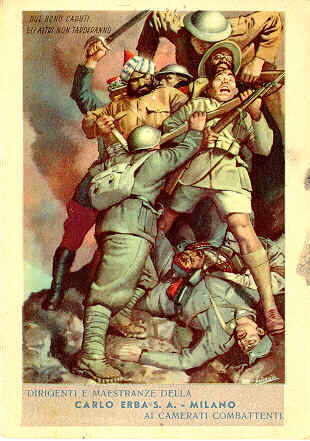
The Italian Campaign continued.

An Italian propaganda postcard from the early war years, depicting Italian soldiers locked in mortal combat with British and Indian troops.
The terrain and weather in Italy were as much an enemy as the Germans, a central ridge of mountains (the Apennines) some of which were 6,000 feet high and had snow as early as October, ran down the center of the 'boot'. Off of this, a series of ridges runs down to the coast on either side, between these ridges are deep valleys and rivers with only a few coastal strips of flat land, hardly ideal tank country! It was infantry country and the two allied armies fighting their way north would be separated by the Apennines and would have to slog from ridge to ridge and river to river facing freezing winters and hot dusty summers as they went.
The Germans originally believed that even though they could hold a great defensive advantage, the allies could always land an amphibious force behind their defensive line and outflank them. After the near debacle at Salerno the Germans changed their minds about retreating all the way back to the Alps where they could not be outflanked and there was also the psychological factor of a strong defence in Italy when other fronts were crumbling. On October 4, Hitler ordered Kesselring to hold a line across Italy between Naples and Rome and sent some reinforcements in the shape of two infantry divisions and some artillery. The allies were caught unawares by the new German strategy, after reading decoded German messages they were convinced that the Germans would retreat rapidly north with only a few delaying actions along the way. Now however, Eisenhower knew that he had a hard and bitter fight on his hands before the allies reached Rome.
Seven experienced divisions were taken from Italy and sent to England to prepare for the Normandy invasion leaving only 14 allied divisions to face the Germans 20 odd divisions who sat behind impressive defences. With the bad weather of winter coming on, the allied air superiority would be nullified and their advantage in motorized transport would be cancelled by the rain and mud that would soon be on it's way. The first obstacle to deal with was the Volturno river, flooded after weeks of rain. The American 3rd and 34th divisions crossed the Volturno on the night of October 12-13 meeting only light resistance from the partially in place 3rd Panzer Division, but the attack nearly faltered through lack of supplies (the Germans held all the good bridges). The Engineers suffered badly from German fire while trying to build bridges across the river. Due to the Engineers gutsy efforts, a bridge was finished and by the 14th the bridgehead was four miles deep.

A Bailey Bridge under construction.
(This time without hindrance from the Germans)
The British had a rougher time with their river crossing, they had very little bridging equipment and the river was so flooded that fording was out of the question. The best place to attack was near Cancello, several battalions of the 46th division got across under heavy fire and established a small bridgehead, although one of these battalions was overrun after a day long fight. The 56th and 7th armored divisions made diversionary attacks and were beaten up quite badly before also establishing a very tenuous hold on the north bank of the river. Several tanks bogged down in the soft ground and others were held up by nonmetallic mines that had to be slowly cleared by hand, But by October 14th with the Naval guns once again saving what was nearly another Salerno situation, a secure bridgehead had been established at the cost of over 600 casualties. The Germans began a gradual withdrawal north, and by the 19th of October the allies had complete control of the Volturno river, although the worst was yet to come as the Germans would begrudge them every ridge, valley and river on the muddy, tortuous road to Rome.